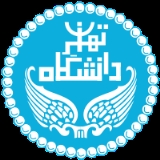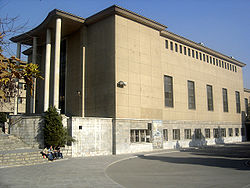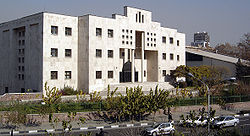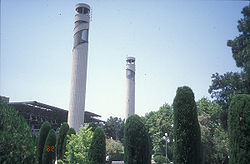
University of Tehran
Encyclopedia

Iran
Iran , officially the Islamic Republic of Iran , is a country in Southern and Western Asia. The name "Iran" has been in use natively since the Sassanian era and came into use internationally in 1935, before which the country was known to the Western world as Persia...
's oldest university. Located in Tehran
Tehran
Tehran , sometimes spelled Teheran, is the capital of Iran and Tehran Province. With an estimated population of 8,429,807; it is also Iran's largest urban area and city, one of the largest cities in Western Asia, and is the world's 19th largest city.In the 20th century, Tehran was subject to...
, the university is among the most prestigious in the country, and is consistently selected as the first choice of many applicants in the annual nationwide entrance exam for top Iranian universities. Based on its historical, socio-cultural and political pedigree, as well as its research and teaching profile, UT has been nicknamed "The mother university of Iran" . The university offers 111 bachelor degree programs, 177 masters' degree programs, and 156 Ph.D. programs. The school's renowned undergraduate and graduate engineering programs require that prospective applicants take a comprehensive entrance exam. Only candidates scoring in the top one percent or better are offered admission.
History
In 1928, Professor Mahmoud HessabyMahmoud Hessaby
Sayyed Mahmoud Hessaby was a prominent Iranian scientist, researcher and distinguished professor of University of Tehran...
proposed to the Minister of Education, the Late Ali Asghar Hekmat, that Iran establish a comprehensive institute that would cover most of the sciences.
Hekmat, in collaboration with the French-born architect Andre Godard
André Godard
André Godard was a French born archeologist, architect and art historian.Godard was born in Chaumont. A graduate of the École des Beaux-Arts of Paris, he designed the National Museum of Iran and was appointed its first director in 1936. He was also instrumental in the design of Tehran University...
and his team of European architects, ultimately designed what would become the master plan of the university's main campus.
In 1934, the formerly males-only university opened its doors to women as part of the country's sweeping universal education policy. The school was officially inaugurated that same year.
In 1986, the Iranian parliament, known as the Majlis of Iran, stipulated that the university's overcrowded College of Medicine be separated into the independent Tehran University of Medical Sciences
Tehran University of Medical Sciences
- General and History :Tehran University of Medical Sciences is the largest and "most distinguished", and most highly ranked medical school of Iran. In September 2008, the health minister of Iran - General and History :Tehran University of Medical Sciences (TUMS) is the largest and "most...
(TUMS), and that TUMS be placed under the leadership of the new Ministry of Health and Medical Education. With over 13,000 current students, TUMS remains the best medical school in Iran.
Colleges
At present, UT comprises 40 faculties, institutes, as well as centers of research and education. The university consists of seven campuses:- The central Pardis campus, on Enghelab Ave, is the oldest and best known of the campuses.
- North Kargar Campus is where most of the dormitories are located.
- KarajKarajKaraj is a city in and the capital of Karaj County, Alborz Province, Iran. At the 2006 census, its population was 1,377,450, in 385,955 families, , making it the fifth-largest city in Iran after Tehran, Mashhad, Isfahan and Tabriz.) It is situated west of Tehran, at the foothills of the Alborz...
campus http://utcan.ut.ac.ir/en/index.aspx of agriculture and natural resources - VaraminVaraminVaramin is a city in and the capital of Varamin County, Tehran Province, Iran. At the 2006 census, its population was 208,569, in 53,639 families.Varamin has an extensive history...
College - KishKish (Sumer)Kish is modern Tell al-Uhaymir , and was an ancient city of Sumer. Kish is located some 12 km east of Babylon, and 80 km south of Baghdad ....
College - QomQomQom is a city in Iran. It lies by road southwest of Tehran and is the capital of Qom Province. At the 2006 census, its population was 957,496, in 241,827 families. It is situated on the banks of the Qom River....
College http://qc.ut.ac.ir/en/index.htm - Choka Campus
Former Campuses
- KarajKarajKaraj is a city in and the capital of Karaj County, Alborz Province, Iran. At the 2006 census, its population was 1,377,450, in 385,955 families, , making it the fifth-largest city in Iran after Tehran, Mashhad, Isfahan and Tabriz.) It is situated west of Tehran, at the foothills of the Alborz...
Campus, which, until 1981, was known as the University of Tehran School of Finance and Commerce. It was subsequently renamed as the Allameh Tabatabaii UniversityAllameh Tabatabaii UniversityAllameh Tabatabai University , is a public university in Tehran, Iran, under the supervision of the Ministry of Sciences, Research and Technology...
.
Research & Facilities
The University of Tehran hosts many cultural and academic activities on the national and international levels. UT enjoys the cooperation of foreign countries in holding international conferences, seminars and workshops. In 2008, close to 1,000 UT professors and graduate students have taken part in international conferences with university funding. Furthermore, UT regularly hosts many delegations and professors from abroad.University of Tehran is appointed as a Center of Excellence (fa:قطب علمی) by Iran's Ministry of Science and Technology in the fields of "Evaluation and improvement of irrigation networks", "Breeding and Biotechnology of trees", "Farming, Grading and Biotechnology", "Applied Electromagnetic Systems", "Land Logistics", "Sustainable Urban Planning and Development", "Architectural Technology", "Biological Control of Pests and Plant Diseases", "Rural Studies and Planning", "High-Performance Materials", "Control and Intelligent Processing", "Sustainable Management of Watershed", "Applied Management of Fast Growing Wood Species", "Surveying and Disaster Management", "Engineering and Infrastructure Management", "Oil and Gas".This appointment is based on national standing based on research achievements and invested funding in the mentioned topics.Fifteen percent of the country’s Centers of Excellence, as recognized by the government, are located at the University of Tehran, which along with more than 40 research centers ensure UT’s commitment to research. Together, over 3,500 laboratories are active in these centers and in the faculties. In addition, the University of Tehran publishes more than 50 scientific journals, some of which have the ISI index.
The Central Library and Documentation Center of the University of Tehran has been a member of the International Federation of Library Associations and institutions (IFLA) since 1967. The Central Library is the largest academic library in Iran. The library compliments the 35 specialized libraries based at different faculties, all with the aim of advancing the research goals of the University. Currently the Central Library and Documentation Center is offering its services to more than 65 thousand members. It hosts more than 5,000 users daily. The library offers its resources under 13 main collections (most of which have been donated by distinguished professors of the University). The manuscript collection of the University of Tehran includes over 17,000 volumes of manuscripts in Persian, Arabic and Turkish. The library also hosts a state of the art center for the preservation of manuscripts.
The University of Tehran Press (UTP), which focuses on publishing academic books, has published over 5,000 books up until today, and currently publishes on average more than one book per day. UTP has over 96 distribution agents throughout the country as well as one in Afghanistan.
Endowment
University of Tehran is a public university and its funding is provided by the government of Iran. For the top ranks of the national university entrance exam, education is free in all public universities. The people with ranks below the normal capacity of the universities will be required to pay part or all of the tuition. In 2011 University of Tehran with an amount equivalent to 800 million dollars got the highest budget among all universities in Iran.Emblems
The emblemEmblem
An emblem is a pictorial image, abstract or representational, that epitomizes a concept — e.g., a moral truth, or an allegory — or that represents a person, such as a king or saint.-Distinction: emblem and symbol:...
of the University of Tehran, which was designed by Dr. Mohsen Moghadam, a late faculty member of the Faculty of Fine Arts, is based on an image, which can be found in the stucco
Stucco
Stucco or render is a material made of an aggregate, a binder, and water. Stucco is applied wet and hardens to a very dense solid. It is used as decorative coating for walls and ceilings and as a sculptural and artistic material in architecture...
relief and seals of the Sasanid period. In this case, it is a copy from a stucco relief discovered in the city of Ctesiphon
Ctesiphon
Ctesiphon, the imperial capital of the Parthian Arsacids and of the Persian Sassanids, was one of the great cities of ancient Mesopotamia.The ruins of the city are located on the east bank of the Tigris, across the river from the Hellenistic city of Seleucia...
.
The seal symbolized ownership. In the Sassanid period, these seals were used in stucco reliefs, coins, and silver utensils as a family symbol. Since the alphabet of Sasanid Pahlavi’s script was used in these badges, they have the nature of a monogram as well.
The motif is placed between two eagle wings. One can also find these motifs in other images of this period, such as in royal crowns, particularly at the end of the Sasanid period. Crowns with these seals have been called “two-feather crowns” in The Shahnameh. The motif between the wings was made by combining Pahlavi scripts. Some scholars have tried to read these images. The script is in the form of “Afzoot” (Amrood), which means plentiful and increasing.
Main entrance
The University of Tehran main entrance was designed in 1965 by Korosh Farzami, one of the students of the faculty of Fine Arts of the University. The structural engineer was an Armenian-Iranian by the name of Simon Sarkissian.For the importance of the University, this gates have gradually become the symbol of Iran's Higher Education system. University of Tehran gates are depicted on the reverse of the Iranian 500 rials banknote.Faculties


- Faculty of TheologyTheologyTheology is the systematic and rational study of religion and its influences and of the nature of religious truths, or the learned profession acquired by completing specialized training in religious studies, usually at a university or school of divinity or seminary.-Definition:Augustine of Hippo...
- Faculty of ScienceScienceScience is a systematic enterprise that builds and organizes knowledge in the form of testable explanations and predictions about the universe...
(1934) - Faculty of LiteratureLiteratureLiterature is the art of written works, and is not bound to published sources...
, PhilosophyPhilosophyPhilosophy is the study of general and fundamental problems, such as those connected with existence, knowledge, values, reason, mind, and language. Philosophy is distinguished from other ways of addressing such problems by its critical, generally systematic approach and its reliance on rational...
and Educational Science - Faculty of MedicineMedicineMedicine is the science and art of healing. It encompasses a variety of health care practices evolved to maintain and restore health by the prevention and treatment of illness....
(1934) - Faculty of PharmacyPharmacyPharmacy is the health profession that links the health sciences with the chemical sciences and it is charged with ensuring the safe and effective use of pharmaceutical drugs...
(1934) - Faculty of DentistryDentistryDentistry is the branch of medicine that is involved in the study, diagnosis, prevention, and treatment of diseases, disorders and conditions of the oral cavity, maxillofacial area and the adjacent and associated structures and their impact on the human body. Dentistry is widely considered...
(1939) - Faculty of EngineeringEngineeringEngineering is the discipline, art, skill and profession of acquiring and applying scientific, mathematical, economic, social, and practical knowledge, in order to design and build structures, machines, devices, systems, materials and processes that safely realize improvements to the lives of...
(Fanni) (1942) - Faculty of LawLawLaw is a system of rules and guidelines which are enforced through social institutions to govern behavior, wherever possible. It shapes politics, economics and society in numerous ways and serves as a social mediator of relations between people. Contract law regulates everything from buying a bus...
and Political SciencePolitical sciencePolitical Science is a social science discipline concerned with the study of the state, government and politics. Aristotle defined it as the study of the state. It deals extensively with the theory and practice of politics, and the analysis of political systems and political behavior... - Faculty of EconomicsEconomicsEconomics is the social science that analyzes the production, distribution, and consumption of goods and services. The term economics comes from the Ancient Greek from + , hence "rules of the house"...
Later more faculties were founded:
- Faculty of Fine Arts (1941)
- Faculty of Veterinary MedicineVeterinary medicineVeterinary Medicine is the branch of science that deals with the prevention, diagnosis and treatment of disease, disorder and injury in non-human animals...
(1943) - Faculty of AgricultureAgricultureAgriculture is the cultivation of animals, plants, fungi and other life forms for food, fiber, and other products used to sustain life. Agriculture was the key implement in the rise of sedentary human civilization, whereby farming of domesticated species created food surpluses that nurtured the...
(1945) - Faculty of ManagementManagementManagement in all business and organizational activities is the act of getting people together to accomplish desired goals and objectives using available resources efficiently and effectively...
(1954) - Faculty of EducationEducationEducation in its broadest, general sense is the means through which the aims and habits of a group of people lives on from one generation to the next. Generally, it occurs through any experience that has a formative effect on the way one thinks, feels, or acts...
(1954) - Faculty of Natural ResourceNatural resourceNatural resources occur naturally within environments that exist relatively undisturbed by mankind, in a natural form. A natural resource is often characterized by amounts of biodiversity and geodiversity existent in various ecosystems....
s (1963) - Faculty of EconomicsEconomicsEconomics is the social science that analyzes the production, distribution, and consumption of goods and services. The term economics comes from the Ancient Greek from + , hence "rules of the house"...
(1970) - Faculty of Social SciencesFaculty of Social Sciences, University of TehranFaculty of Social Sciences of University of Tehran was founded about 1972 by merging two foundations and became the first independent higher education faculty of Social Sciences in Iran.-External links:* *...
(~1972) - Faculty of Foreign LanguagesFaculty of Foreign Languages, University of TehranThe Faculty of Foreign Languages at the University of Tehran was founded in 1989 when the departments of English, French, Italian, German, and Russian were brought together at the Faculty of Letters and Humanities....
http://ffl.ut.ac.ir/ (1989) - Faculty of Environmental StudiesEnvironmental studiesEnvironmental studies is the academic field which systematically studies human interaction with the environment. It is a broad interdisciplinary field of study that includes the natural environment, built environment, and the sets of relationships between them...
(1992) - Faculty of Physical EducationPhysical educationPhysical education or gymnastics is a course taken during primary and secondary education that encourages psychomotor learning in a play or movement exploration setting....
- Faculty of GeographyGeographyGeography is the science that studies the lands, features, inhabitants, and phenomena of Earth. A literal translation would be "to describe or write about the Earth". The first person to use the word "geography" was Eratosthenes...
(~2002) - Faculty of World Studies (~2007)
- Faculty of EntrepreneurshipEntrepreneurshipEntrepreneurship is the act of being an entrepreneur, which can be defined as "one who undertakes innovations, finance and business acumen in an effort to transform innovations into economic goods". This may result in new organizations or may be part of revitalizing mature organizations in response...
http://ent.ut.ac.ir/
In 1992, the faculties of Medicine, Dentistry and Pharmacology seceded to become the Tehran University of Medical Sciences
Tehran University of Medical Sciences
- General and History :Tehran University of Medical Sciences is the largest and "most distinguished", and most highly ranked medical school of Iran. In September 2008, the health minister of Iran - General and History :Tehran University of Medical Sciences (TUMS) is the largest and "most...
but is still located at the main campus (The central Pardis).
Institutes
University of Tehran also co-ordinates several major institutes:- Institute of Biochemistry and BiophysicsInstitute of Biochemistry and BiophysicsInstitute of Biochemistry and Biophysics is a research institute in Iran founded in 1976 to conduct research in biological sciences and related fields. It is affiliated with the University of Tehran and is located in its main campus....
- Institute of GeophysicsInstitute of GeophysicsThe Institute of Geophysics is the name of a scientific institute in Iran.The Institute of Geophysics manages Iran's national seismic data, and directs Iran's national calendar, which is based on the Solar calendar. The authoring of Iran's official lunar and solar calendars each year is...
- The International Research Center for Coexistence with Deserts
- Institute of History of Science http://utihs.ut.ac.ir/
- Institute for North American and European Studies http://inaes.ut.ac.ir/
- Institute of Electrotechnic
- Center for Women's Studies http://cws.ut.ac.ir/
- Applied Management Research Center http://marc.ut.ac.ir/
- Dehkhoda Dictionary InstituteDehkhoda Dictionary InstituteThe Dehkhoda Dictionary Institute is the main official international center for teaching the Persian language and literature in Iran. It was founded in 1945 and is now part of the University of Tehran...
- Vehicle, Fuel, and Environment Research Institute
- Turbo Machine Institute
- Institute of Petroleum Engineering
- Water Institute
- The Research Institute of Energy Planning and Management
- The Engineering Optimization Research Group
- Biomaterial Research Institute
- Advanced Material Research Institute
- Inorganic Material Research Institute
World rankings
Academic Ranking of World UniversitiesAcademic Ranking of World Universities
The Academic Ranking of World Universities , commonly known as the Shanghai ranking, is a publication that was founded and compiled by the Shanghai Jiaotong University to rank universities globally. The rankings have been conducted since 2003 and updated annually...
(ARWU/Shanghai Ranking)
2011: International rank : 301-400, National rank : 1
2010: International rank : 401-500, National rank : 1
2009: International rank : 402-501, National rank : 1
QS World University Rankings
QS World University Rankings
The QS World University Rankings is a ranking of the world’s top 500 universities by Quacquarelli Symonds using a method that has published annually since 2004....
2010: International rank : 401-450, National rank : 1
2009: International rank : 368, National rank : 1
2008: International rank : 401-500, National rank : 1
2007: International rank : 539, National rank : 2
Webometrics Ranking of World Universities
Webometrics Ranking of World Universities
The Webometrics Ranking of World Universities, also known as Ranking Web of World Universities, is ranking system for the world's universities based on a composite indicator that takes into account both the volume of the Web contents and the visibility and impact of these web publications...
2011: International rank : 708, National rank : 1
2010: International rank : 899, National rank : 1
2009: International rank : 987, National rank : 1
2008: International rank : 1083, National rank : 1
2007: International rank : 1463, National rank : 1
SCImago rankings
2011: International rank : 321, National rank : 1
2010: International rank : 473, National rank : 1
2009: International rank : 308, National rank : 1
Political role

Perhaps, to historians, the University of Tehran is most notably remembered for its key roles in the political events of recent history. It was in front of the same gates of this school that The Shah's
Mohammad Reza Pahlavi
Mohammad Rezā Shāh Pahlavi, Shah of Iran, Shah of Persia , ruled Iran from 16 September 1941 until his overthrow by the Iranian Revolution on 11 February 1979...
army opened fire on dissident students, killing many and further triggering the 1979 revolution
Iranian Revolution
The Iranian Revolution refers to events involving the overthrow of Iran's monarchy under Shah Mohammad Reza Pahlavi and its replacement with an Islamic republic under Ayatollah Ruhollah Khomeini, the leader of the...
of Iran.
It was there and 20 years later in July 1999 that, albeit, a much smaller number of dissident students confronted the police.
University of Tehran (UT) has always been a bastion of political movement and ideology. At UT the leaders of the country deliver some of their most potent speeches often on Friday during prayers. Since the 1979 Islamic Revolution, the main campus of the university and its surrounding streets have been the site for Tehran's Friday prayers.
The political and social role of University of Tehran in the Iranian domestic arena has continued to be so pronounced that in November 2005 (to February 2008) a senior Islamic scholar became chancellor of the university, replacing Dr. Faraji-dana (professor of electrical engineering faculty). Ayatollah Abbasali Amid Zanjani
Abbasali Amid Zanjani
Ayatollah Abbasali Amid Zanjani was an Iranian politician and cleric. He was the only cleric president of University of Tehran, served from 2005 to 2008. -Early life:...
(عباسعلی عميد زنجانی) is a professor in Law, is known for his strong ties to Ayatollah Khomeini in the 1979 revolution, and had spent time in the Shah's prisons before the Islamic Revolution. In February 2008, an Iranian economist, Dr. Farhad Rahbar, a former vice president of Iran and head of Management and Planning Organization of Iran, became the new (31st) chancellor of the university.
One hundred and nineteen faculty members of the University of Tehran are said to have resigned on June 15, 2009 to protest the attack on university dorms in the wake of contested 2009 presidential elections
Iranian presidential election, 2009
Iran's tenth presidential election was held on 12 June 2009, with incumbent Mahmoud Ahmadinejad running against three challengers. The next morning the Islamic Republic News Agency, Iran's official news agency, announced that with two-thirds of the votes counted, Ahmadinejad had won the election...
: although clear follow-up data is hard to establish, it seems that most or all resignations were not accepted.
See also
- University of Tehran main entranceUniversity of Tehran main entranceThe University of Tehran main entrance was designed in 1965 by Korosh Farzami, one of the students of the faculty of Fine Arts of the University.The structural engineer was an Armenian-Iranian by the name of Simon Sarkissian....
- Academy of GundishapurAcademy of GundishapurThe Academy of Gondishapur , also Jondishapur , was a renowned academy of learning in the city of Gundeshapur during late antiquity, the intellectual center of the Sassanid empire. It offered training in medicine, philosophy, theology and science. The faculty were versed in the Zoroastrian and...
- NizamiyyahNizamiyyahThe Nezamiyehs , are a group of the medieval institutions of higher education established by Khwaja Nizam al-Mulk in the eleventh century in Iran. The name nizamiyyah derives from his name...
- Dar al-Funun

